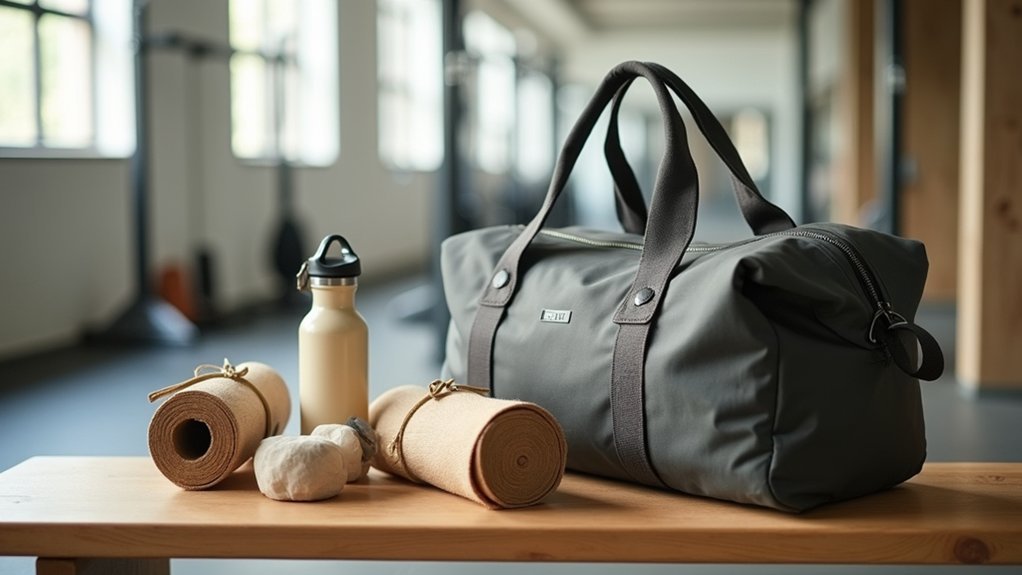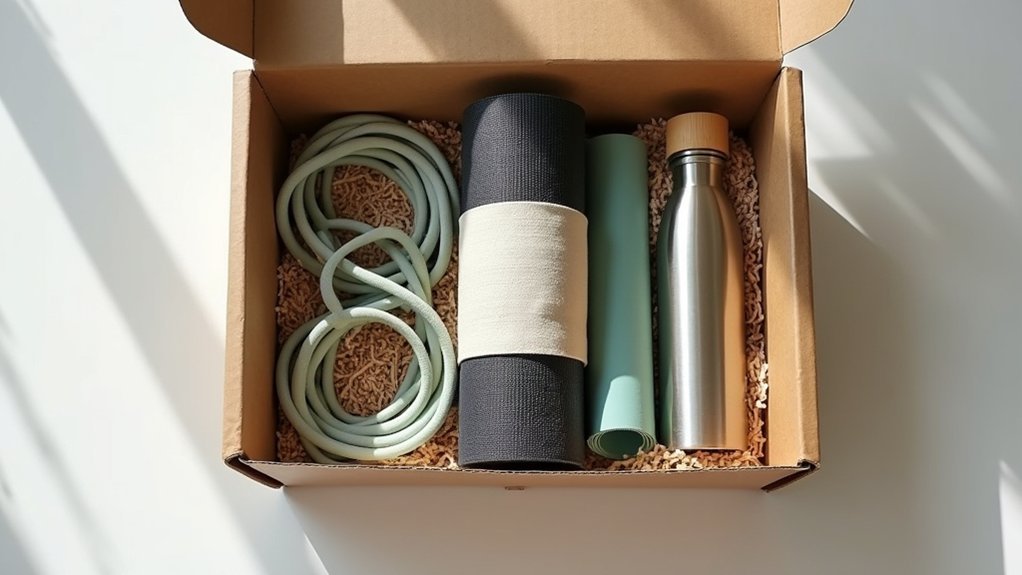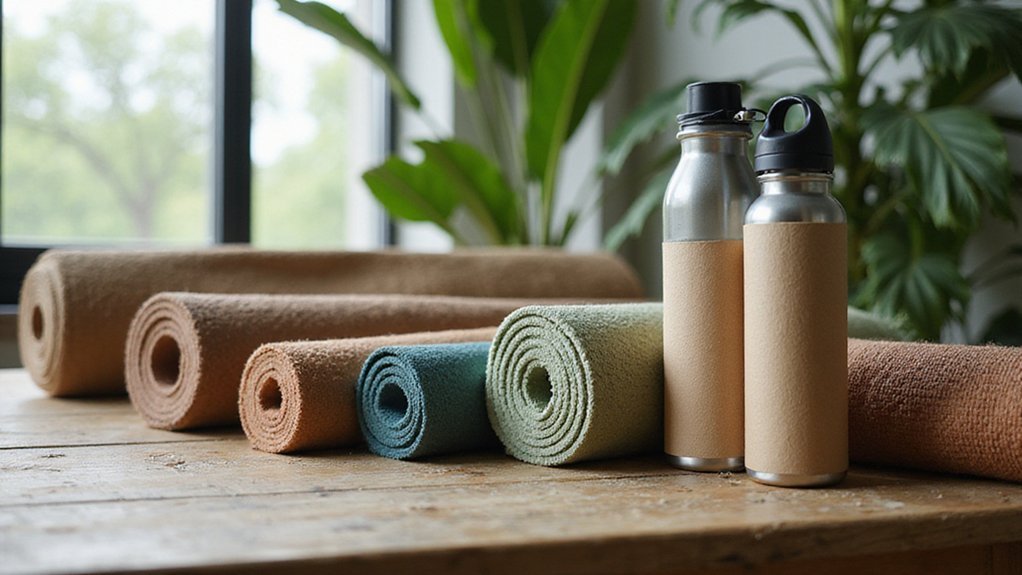You’re witnessing a transformative moment in fitness gear packaging. Traditional single-use materials are giving way to innovative, zero-waste solutions that challenge industry norms. As brands like Girlfriend Collective reimagine product design, they’re proving sustainability doesn’t compromise performance. The numbers tell a compelling story: each eco-friendly package represents a significant reduction in environmental waste. But how are these companies cracking the code of sustainable packaging, and what does it mean for your next workout ensemble? The revolution is just beginning.
Key Takeaways
- Girlfriend Collective pioneers zero-waste packaging by implementing recyclable and compostable solutions for fitness apparel and accessories.
- Wolven demonstrates leadership in sustainable packaging within the fitness gear industry through innovative material choices and eco-conscious design.
- TenTree integrates environmental impact directly into their business model by planting trees with each purchase and using sustainable packaging strategies.
- MOVE by MATE showcases commitment to zero-waste packaging through Climate Neutral certification and transparent sustainability practices in fitness gear production.
- Pact reduces packaging waste by focusing on minimalistic designs, post-consumer recycled content, and compostable materials in fitness and lifestyle products.
The Environmental Impact of Traditional Packaging

While traditional packaging in the fitness industry might seem innocuous, it’s a silent environmental menace that’s rapidly escalating global waste challenges. You’re witnessing an unprecedented crisis where 78 million tons of plastic packaging are produced annually, with 30% destined for single-use disposal. This plastic waste generates substantial greenhouse gas emissions and contributes to devastating environmental impacts.
When you choose fitness gear wrapped in conventional packaging, you’re indirectly supporting a system that creates long-term ecological damage. The production of these materials depletes non-renewable resources and fills landfills with non-decomposable waste that persists for hundreds of years. Consumer backlash is growing as awareness increases, demanding sustainable alternatives and eco-friendly production methods that prioritize environmental responsibility over convenience.
What Defines Zero-Waste Packaging in Fitness Gear

As consumer environmental consciousness rises, zero-waste packaging in fitness gear represents a critical paradigm shift toward sustainable product design. You’ll recognize these packaging solutions through key characteristics: minimal design, recyclable materials, and post-consumer recycled content that supports a circular economy. Zero-waste packaging prioritizes eco-friendly approaches that dramatically reduce environmental impact, focusing on materials that are either compostable or biodegradable. By utilizing transparent labeling, brands communicate their sustainable practices, empowering you to make informed purchasing decisions. With 74% of consumers willing to pay more for environmentally responsible packaging, fitness gear companies are innovating packaging strategies that minimize waste while maintaining product protection. These solutions demonstrate that sustainability and functionality can coexist seamlessly in modern product design.
Top Sustainable Brands Revolutionizing Packaging Practices

Because sustainable packaging has become a critical priority in the fitness gear industry, innovative brands are transforming traditional approaches to product design and environmental responsibility. Brands like Girlfriend Collective, Pact, and Wolven are leading this revolution by implementing recyclable and compostable packaging solutions that minimize waste. TenTree goes beyond packaging, planting trees with each purchase while ensuring eco-friendly material choices. MOVE by MATE demonstrates extensive commitment through Climate Neutral certification and sustainable packaging practices.
These brands understand that reducing environmental impact isn’t just about the product, but the entire lifecycle. By prioritizing recyclable materials, minimal packaging design, and innovative waste reduction strategies, they’re setting new standards in fitness gear packaging. Consumers can now choose gear that aligns with their sustainability values without compromising performance or style.
Innovative Materials Transforming Packaging Design

Transforming the fitness gear packaging landscape, innovative materials are redefining sustainability through strategic design and environmental consciousness. Cutting-edge solutions like recycled cardboard and biodegradable plastics are revolutionizing packaging design, offering sustainable alternatives that dramatically reduce waste. You’ll find these eco-friendly products dramatically lower carbon footprint while maintaining product integrity.
Minimal packaging approaches leverage plant-based inks and compostable materials, creating recyclable packaging that breaks down naturally and supports environmental health. Brands are strategically integrating innovative materials that minimize environmental impact without compromising functionality. By reimagining packaging as a critical sustainability lever, companies are developing solutions that transform waste management, proving that thoughtful material selection can drive significant ecological progress in the fitness gear industry.
How Zero-Waste Strategies Benefit Consumers and the Planet

While zero-waste packaging strategies revolutionize the fitness gear industry, consumers and the planet reap substantial environmental benefits. By embracing zero-waste packaging, you’ll contribute to a more sustainable future through:
- Reducing carbon footprint by minimizing transportation emissions and resource consumption
- Supporting a circular economy with eco-friendly materials that can be recycled or composted
- Encouraging responsible purchasing decisions that prioritize environmental sustainability
- Driving brand innovation towards more responsible manufacturing processes
Your choice to invest in fitness gear with zero-waste packaging directly impacts global environmental health. These strategies not only minimize landfill contributions but also create a meaningful connection between consumers and sustainable practices. As brands respond to increasing demand for eco-friendly solutions, your purchasing power becomes a catalyst for transformative change in the fitness industry’s environmental responsibility.
Challenges and Solutions in Sustainable Packaging
As consumers increasingly champion sustainable practices, the fitness gear industry confronts complex packaging challenges that demand innovative solutions. The high cost of eco-friendly materials often deters brands from shifting to sustainable packaging, despite growing environmental consciousness. However, companies like Girlfriend Collective and Pact are leading the charge by implementing biodegradable and recycled packaging strategies that notably reduce waste.
With approximately 30% of global packaging waste originating from apparel and accessories, brands must prioritize innovation in sustainable packaging. By adopting minimalistic designs and compostable materials, fitness gear manufacturers can dramatically decrease their environmental impact. These solutions not only address packaging waste but also resonate with environmentally aware consumers seeking responsible consumption options.
Consumer Role in Supporting Zero-Waste Initiatives
When consumers actively champion zero-waste packaging in fitness gear, they become powerful catalysts for environmental change. Your choices can transform the industry through strategic engagement:
- Select fitness gear brands with transparent packaging policies that prioritize eco-friendly packaging and minimize waste
- Provide direct feedback to brands about sustainable practices and circular economy principles
- Support companies utilizing compostable or biodegradable materials in their packaging solutions
- Join community environmental initiatives focused on reducing plastic waste in fitness gear manufacturing
Future Trends in Eco-Friendly Fitness Gear Packaging
The sustainable packaging revolution in fitness gear is rapidly accelerating, driven by innovative technologies and consumer demand for environmentally responsible solutions. You’ll see biodegradable materials and recycled plastics transforming the fitness industry’s approach to packaging, with brands prioritizing zero-waste packaging strategies that minimize carbon footprint.
Expect eco-friendly products to become the norm, not the exception. Companies are investing in 100% recyclable packaging that supports a circular economy, responding to growing consumer preferences for sustainable solutions. Innovations in packaging design will focus on minimalistic approaches that reduce waste while maintaining product protection.
The future of fitness gear packaging is clear: sustainable, innovative, and environmentally conscious, meeting the evolving expectations of environmentally aware consumers.
Frequently Asked Questions
Can Zero-Waste Packaging Actually Protect Fitness Gear During Shipping?
You’ll find that sustainable materials and protective designs can guarantee shipping safety without compromising gear integrity. Innovative eco-friendly alternatives now offer material durability, shipping efficiency, and reduced environmental impact, proving zero-waste packaging isn’t just responsible—it’s practical.
Are Zero-Waste Packaging Solutions More Expensive for Consumers?
You’d think eco-friendly packaging costs more, right? Surprisingly, market demand and brand loyalty are driving sustainability trends, making zero-waste solutions competitively priced. Consumer education reveals long-term savings through innovative, eco-friendly materials and waste reduction strategies.
How Long Do Biodegradable Packaging Materials Typically Take to Decompose?
You’ll find biodegradable materials decompose from weeks to years, depending on composition. Compostable alternatives typically break down in 3-6 months, offering significant waste reduction and supporting sustainable packaging innovation with minimal environmental impact.
What Specific Recycling Methods Work Best for Fitness Gear Packaging?
You’ll maximize recycling by prioritizing clean, sorted packaging materials, embracing innovative solutions like mono-material designs, and supporting circular economy practices that align with evolving sustainability standards and eco-friendly waste management techniques.
Do Zero-Waste Packaging Practices Impact Product Quality or Durability?
You’ll find zero-waste packaging doesn’t compromise product quality. Rigorous durability testing shows eco-friendly alternatives maintain material strength, with sustainability concerns balanced against performance comparisons and consumer perceptions of brand reputation.
Conclusion
You’re standing at the crossroads of innovation and sustainability. Each packaging choice ripples through our ecosystem, transforming fitness gear from environmental burden to regenerative solution. By supporting zero-waste brands, you’re not just buying products—you’re casting a vote for planetary health. The future isn’t just green; it’s a collaborative revolution where consumers and brands unite to redefine responsible consumption, one eco-conscious package at a time.





